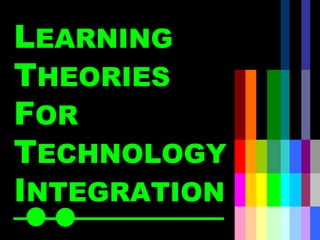
Learning theories for technology integration
- 1. L EARNING T HEORIES F OR T ECHNOLOGY I NTEGRATION
- 4. OBJECTIVISM FROM CONSTRUCTIVISM. DIFFERENTIATE OBJECTIVISM Learning is transmitted knowledge. Learning has to be teacher directed. Instruction should be directed, systematic and structured. Students should all pass the same test and standardization means accountability. A few technology applications, such as drill and practice and tutorials, are associated with directed instructions. CONSTRUCTIVISM Knowledge is constructed, not transmitted. Instruction is student centered. Students do activities that help them generate their own knowledge. Students show what they have learned in different ways, not just on written test. Some technology applications, such as web-based learning and multimedia production, are associated with inquiry-based learning. Roblyer, M. D., & Doering, A. H. (2010). Integrating educational technology into teaching (5th edition) . Boston MA: Ally & Bacon.
- 5. Behavorist Theory by B. F. Skinner Learning is based on the notion of operant conditioning. Behaviors that are rewarded tend to be exhibited more often than those that are not. Positive and negative reinforcements increase desired behaviors with rewards. Punishment decreases undesirable behaviors with aversive stimuli Learning happens inside the mind and it can not be seen directly. Learning can only be inferred by observing behaviors. Learning can be understood, explained, predicted entirely on the basis of observable events, namely, the behavior of the learner along with its environment antecedents and consequence. Roblyer, M. D., & Doering, A. H. (2010). Integrating educational technology into teaching (5th edition) . Boston MA: Ally & Bacon. DESCRIBE THE LEARNING THEORIES ASSOCIATED WITH O BJECTIVISM ?
- 7. Information-Processing Theory by Atkinson and Shiffrin The mind has three stores. The sensory registers receive information a person senses through receptors. After few seconds, the information is lost or is transferred to the short-term memory. The short-term memory holds the information for few seconds. If the information is not processed then it is lost . Otherwise, it will be transferred to the long-term memory. The long-term memory will hold the processed information indefinitely. Learning is encoding information into human memory. The mind is compared to a computer in which the mind, like a computer, stores information. Roblyer, M. D., & Doering, A. H. (2010). Integrating educational technology into teaching (5th edition) . Boston MA: Ally & Bacon. DESCRIBE THE LEARNING THEORIES ASSOCIATED WITH O BJECTIVISM ?
- 8. System Theory and Systematic Instructional Design Gagne and Briggs believed that learning is most efficient if it is supported by a carefully designed system of instruction. Gagne promoted the instructional task analysis while Briggs offered systematic methods of designing training programs. When these two areas of expertise were combined, it resulted to what is called the system approach to instructional design or systematic instructional design. The theory was a collaborative work of Robert Gagne and Leslie Briggs. Roblyer, M. D., & Doering, A. H. (2010). Integrating educational technology into teaching (5th edition) . Boston MA: Ally & Bacon. DESCRIBE THE LEARNING THEORIES ASSOCIATED WITH O BJECTIVISM ?
- 9. Social Activism Theory by J. Dewey The ultimate aim of education is to help individuals understand their culture and should develop their relationship to and unique roles in the society. Learning is individual growth that comes about through social experiences. Students should be engaged in activities connected to real-world issues and problems. The curriculum of the school should consider the interests of the students and should be taught as integrated topics, rather than as isolated skills. Roblyer, M. D., & Doering, A. H. (2010). Integrating educational technology into teaching (5th edition) . Boston MA: Ally & Bacon. DESCRIBE THE LEARNING THEORIES ASSOCIATED WITH C ONSTRUCTIVISM ?
- 10. Scaffolding Theory by L. Vygotsky Adults (experts) learn differently from children (novices). The difference in the learning ability between the adults and the children is called the Zone of Proximal Development. Adults should teach the children in a scaffolding manner. Teaching should be done in such a way that the instruction is aligned to where the child is, in his or her development stage and help him or her build experiences from that stage. Learning is cognitive development shaped by individual differences and the influence of culture. Roblyer, M. D., & Doering, A. H. (2010). Integrating educational technology into teaching (5th edition) . Boston MA: Ally & Bacon. DESCRIBE THE LEARNING THEORIES ASSOCIATED WITH C ONSTRUCTIVISM ?
- 11. Child Development Theory by J. Piaget Children undergo stages of cognitive development. These stages are sensorimotor (birth – 2 years), preoperational (2 – 7 years), concrete operational (7 – 11 years) and formal operations (12- 15 years). Children develop through these stages by their interaction with their environment. Learning is cognitive growth through neurological and social maturation. Children experience disequilibrium when they encounter unknowns in their environment, respond with assimilation to fit something into their views or accommodation if they want to change their views of something. Roblyer, M. D., & Doering, A. H. (2010). Integrating educational technology into teaching (5th edition) . Boston MA: Ally & Bacon. DESCRIBE THE LEARNING THEORIES ASSOCIATED WITH C ONSTRUCTIVISM ?
- 12. Discovery Learning by J. Bruner Children remember things better if they discovered these things by themselves. Learning is cognitive growth through interaction with the environment. Teachers believed that discovery learning would happen only if a structured type of learning was given first to the learners. Roblyer, M. D., & Doering, A. H. (2010). Integrating educational technology into teaching (5th edition) . Boston MA: Ally & Bacon. DESCRIBE THE LEARNING THEORIES ASSOCIATED WITH C ONSTRUCTIVISM ?
- 13. Multiple Intelligence Theory by H. Gardner There are at least eight independent types of intelligence. These are linguistic, musical, logical-mathematical, spatial, bodily, intrapersonal, interpersonal and naturalist intelligence. Learning is shaped by innate intelligence. Roblyer, M. D., & Doering, A. H. (2010). Integrating educational technology into teaching (5th edition) . Boston MA: Ally & Bacon. DESCRIBE THE LEARNING THEORIES ASSOCIATED WITH C ONSTRUCTIVISM ?